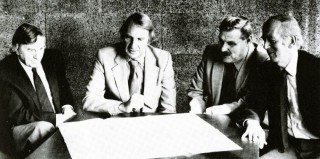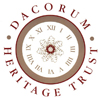Leonard Vincent about the positioning of Stevenage town centre and roads
Different factors had to be taken into consideration for deciding where to place the centre and the roads of Stevenage. Among them: the geography of the area, the viewpoint of Old Town inhabitants and the Ministry's one, and the existing green areas that had to be preserved.
Stevenage Museum

Position of the Town Centre
Stevenage Town Centre is not in the centre of Stevenage at all… in fact, given the position of the railway and the A1(M), it wouldn’t make sense to have it in the geographical centre of the town.
The centre of the town, the Town Centre rather, was not mean to be the geographical centre of the town although ideally you might think that that’s the right thing, but it was located on the you might say on the confluence of the main arteries of the town, they are the main roads through the neighbourhoods verging onto the A1(M) and the industrial main area main road and what is now Lytton Way, the Hitchin/Hertford main road. That confluence was suggested as being the right spot for the Town Centre and on reflection I think it’s right because the problem with Stevenage is this, if there hadn’t been an A1(M) and there hadn’t been a railway where it was, I think you could have designed the town with the centre geographically in the centre but given the fact that that divided the town one third of the town was on the west side of the A1(M) and the railway and the other two thirds were on the other side, you couldn’t possibly geographically put that thing in the centre.
Leonard Vincent

Controversy about road placing
The Ministry wanted to have its say, and this influenced the road planning of Stevenage.
There was also controversy about certain roads on the east side of the Town Centre, which was the Development Corporation called in independent consultants to make representations to the government and themselves, because this was a difference of opinion between Holliday1 and the Corporation and the Ministry….Mind you, if I may say so, I think the Ministry in a way interfered far too much with these domestic issues. I mean, they should have said look you are appointed to get on with the job now get on with the job, if you make a hash of it, you know, you are out on your ear. As it turned out that decision by these consultants to replace that road, which is this one immediately on the east side of the Town Centre, it was meant to be out further……As far as I think was a mistake they should have stuck to the original idea where the town park gardens flowed naturally into the town centre and the, and the car park were served by spurs.

Compromises on road planning
Of course, inhabitants of the Old Town too had their point of view, and sometimes logic had to bend to sentiment.
It meant demolition of certain properties, one of which was a cottage in the north end of Stevenage in which an actor and his wife were living, I shan’t mention names everybody knows. There was a committee formed by some old Stevenage residents to stop that happening to save that cottage. That swayed the development corporation I and my colleagues were instructed to devise a way out. So what you now see this gyratory around part of old Stevenage is a compromise, which I thoroughly disagree with. In other words what‘s really happened is the north part of Stevenage has suffered that gyratory traffic on the whim of several people that a certain cottage should not be removed. My view was all right it’s like all surgery you may have to remove something in order to make the whole thing live decently and properly. Mind you it could still be done I mentioned to a councillor not long ago that if they ever had the courage one day to do it they could still do it because when I planned it, it was in such a way that it still entailed knocking down the property they could get rid of that gyratory. You see what spoiled that part of old Stevenage was that those underpasses had to be put in and all this sort of thing. An underpass has the effect of cutting off places…So that’s something I thoroughly disagreed with, but it had to be carried out because that was the decision that was made.

Constraints to road planning
What the town planners regarded as the main constraints were all the fine lanes, hedgerows and woodlands that were already there. They have been preserved and became part of the new Stevenage.
The main constraint as regards the overall patterns were the existing features and woodlands and things of that sort. Some very fine hedgerows, some very fine lanes which we said must be kept intact as part of the plan of the town, which we did so that is why Stevenage is very fortunate in a way to be able to have all these woodlands within the residential areas or separating the residential areas or something like that, and the old lanes retained.
1. Albert Clifford Holliday (1897-1960) was an English architect and urban planner. He was chief architect and planner of Stevenage New Town from 1947 to 1952.









No Comments
Add a comment about this page